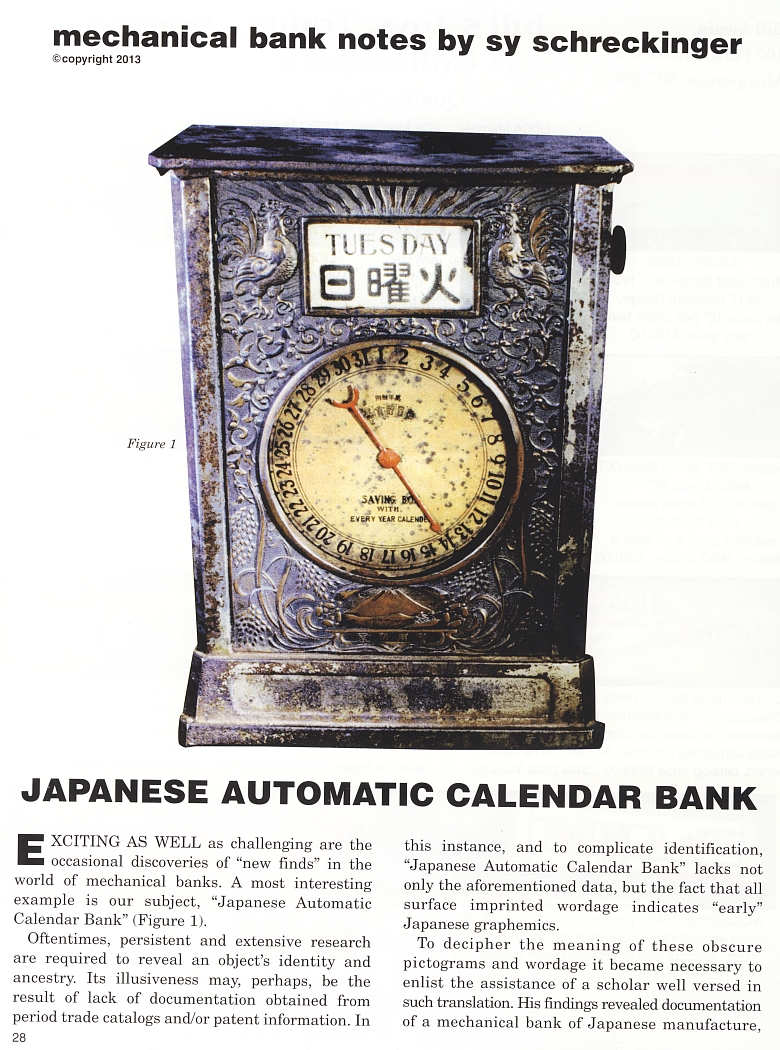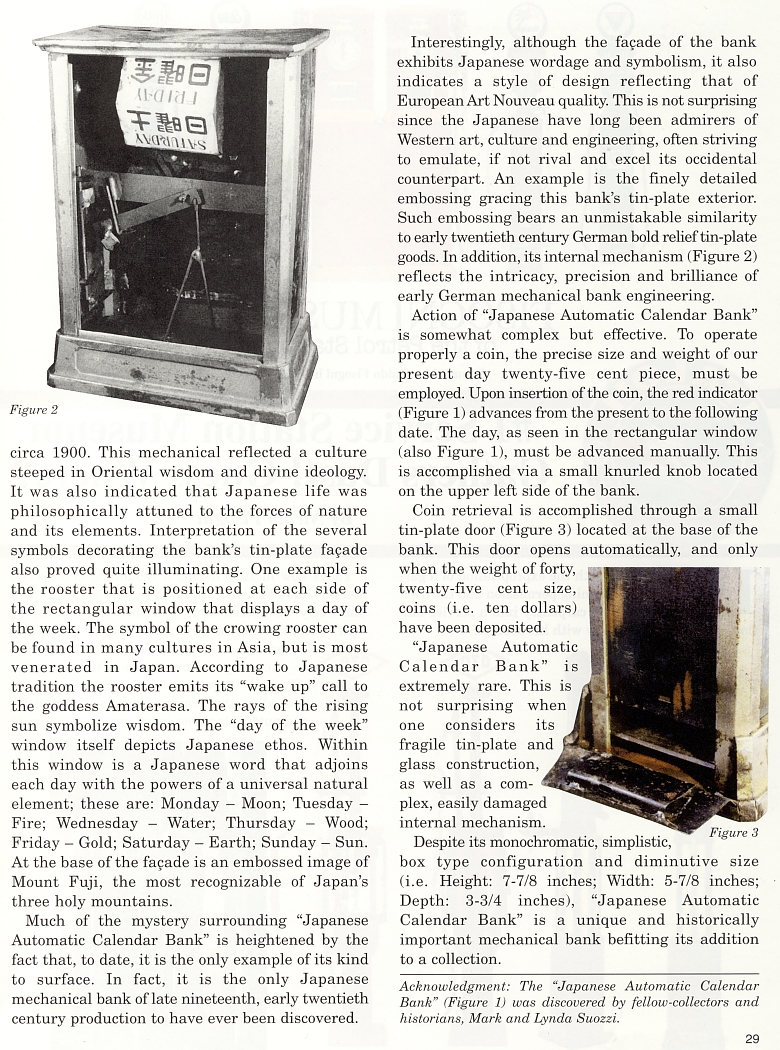|
JAPANESE AUTOMATIC CALENDAR BANK
by Sy Schreckinger – ANTIQUE TOY WORLD Magazine –
March, 2013
EXCITING AS WELL as challenging are the occasional discoveries of "new
finds" in the world of mechanical banks. A most interesting example is
our subject, "Japanese Automatic Calendar Bank" (Figure 1).
Oftentimes, persistent and extensive research are required to
reveal an object's identity and ancestry. Its illusiveness may, perhaps,
be the result of lack of documentation obtained from period trade
catalogs and/or patent information. In this instance, and to complicate
identification, "Japanese Automatic Calendar Bank" lacks not only the
aforementioned data, but the fact that all surface imprinted wordage
indicates "early" Japanese graphemics.
To decipher the meaning of these obscure pictograms and wordage it
became necessary to enlist the assistance of a scholar well versed in
such translation. His findings revealed documentation of a mechanical
bank of Japanese manufacture, circa 1900. This mechanical reflected a
culture steeped in Oriental wisdom and divine ideology. It was also
indicated that Japanese life was philosophically attuned to the forces
of nature and its elements. Interpretation of the several symbols
decorating the bank's tin-plate facade also proved quite illuminating.
One example is the rooster that is positioned at each side of the
rectangular window that displays a day of the week. The symbol of the
crowing rooster can be found in many cultures in Asia, but is most
venerated in Japan. According to Japanese tradition the rooster emits
its "wake up" call to the goddess Amaterasa. The rays of the rising sun
symbolize wisdom. The "day of the week" window itself depicts Japanese
ethos. Within this window is a Japanese word that adjoins each day with
the powers of a universal natural element; these are: Monday — Moon;
Tuesday — Fire; Wednesday — Water; Thursday — Wood; Friday — Gold;
Saturday — Earth; Sunday — Sun. At the base of the facade is an embossed
image of Mount Fuji, the most recognizable of Japan's three holy
mountains.
Much of the mystery surrounding "Japanese Automatic Calendar Bank"
is heightened by the fact that, to date, it is the only example of its
kind to surface. In fact, it is the only Japanese mechanical bank of
late nineteenth, early twentieth century production to have ever been
discovered.
Interestingly, although the facade of the bank exhibits Japanese
wordage and symbolism, it also indicates a style of design reflecting
that of European Art Nouveau quality. This is not surprising since the
Japanese have long been admirers of Western art, culture and
engineering, often striving to emulate, if not rival and excel its
occidental counterpart. An example is the finely detailed embossing
gracing this bank's tin-plate exterior. Such embossing bears an
unmistakable similarity to early twentieth century German bold relief
tin-plate goods. In addition, its internal mechanism (Figure 2) reflects
the intricacy, precision and brilliance of early German mechanical bank
engineering.
Action of "Japanese Automatic Calendar Bank" is somewhat complex
but effective. To operate properly a coin, the precise size and weight
of our present day twenty-five cent piece, must be employed. Upon
insertion of the coin, the red indicator (Figure 1) advances from the
present to the following date. The day, as seen in the rectangular
window (also Figure 1), must be advanced manually. This is accomplished
via a small knurled knob located on the upper left side of the bank.
Coin retrieval is accomplished through a small tin-plate door
(Figure 3) located at the base of the bank. This door opens
automatically, and only when the weight of forty, twenty-five cent size,
coins (i.e. ten dollars) have been deposited.
"Japanese Automatic Calendar Bank" is extremely rare. This is not
surprising when one considers its fragile tin-plate and glass
construction, as well as a complex, easily damaged internal mechanism.
Despite its monochromatic, simplistic, box type configuration and
diminutive size (i.e. Height: 7-7/8 inches; Width: 5-7/8 inches; Depth:
3-3/4 inches), "Japanese Automatic Calendar Bank" is a unique and
historically important mechanical bank befitting its addition to a
collection.
Acknowledgment: The "Japanese Automatic Calendar Bank" (Figure 1)
was discovered by fellow-collectors and historians, Mark and Lynda
Suozzi. |

